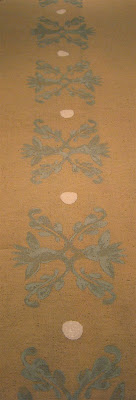
This velvety mushroom appears to be a Phaeolus Schweinitzii. I googled images of it and this specimen in my backyard is hands-down the prettiest of anything I found online. Here is some info about it. I think in its setting next to an old stump and amidst a bed of pine needles, it must be a place where fairies come to take shelter from the rain. See the picture below of its use as a dye for yarns.
Scientific name: Phaeolus schweinitzii (Fr.) Pat.
Derivation of name: Phaeolus means "dark" or "obscure"; schweinitzii means it was named for L.D. von Schweinitz, American mycologist (1780-1834).
Common names: Dye polypore.
Occurrence on wood substrate: Parasitic and saprobic; solitary or in overlapping clusters or rosettes on buried roots and at the base of living conifers, sometimes on dead stumps; rarely reported on deciduous trees; June through November.
Dimensions: Individual caps 4-25 cm wide; clusters up to 60cm (or more); stalks (when present) 1-6 cm long and 1-4 cm thick, branched or unbranched, central or eccentric, sometimes rooting.
Upper surface: Densely matted or wooly, less so with age; ochre to orange or reddish-brown with yellow margin when young, rusty-brown to dark brown in age; somewhat zonate.
Pore surface: Greenish-yellow to yellow or orange when young, bruising brownish, yellowish-brown to dark reddish or rusty-brown in age; pores 0.5-3 per mm.
Edibility: Inedible.
Comments: The Dye polypore is used to prepare dyes for fabrics (Figure 7). This polypore encompasses twigs, needles, and grass as it develops. Check with Bessette or Roody to compare with similar Inonotus tomentosus which is smaller and thinner, does not have the greenish-yellow pore surface, and does not grow in overlapping rosettes. Phaeolus schweinitzii is a significant parasite, often killing the host tree as a result of the root and butt rot it causes.

And here is a gourd I bought at Ingles to bring into work, where everyone this year is obsessed with gourds! Even my sister up in Maryland is goin' gaga for gourds. Must be the year of the gourd. Here is some info about this type of gourd. Some find it rather repulsive; I, on the other hand, think its color is lovely, and I find that the peanut-like warts give it a personality of its own (in a freakish kinda way).


(Yarn image pulled from a webpage by Gary Emberger, Messiah College. The wool color sample was provided by Gail Blakely.)

















































